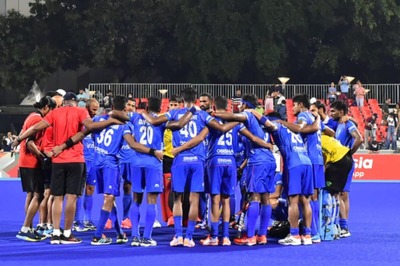
views
A package to relieve farm distress seems to be top-of-the-mind for the BJP government as the country prepares for Lok Sabha elections. This may assuage farmers’ worries but leave the fiscal math in tatters, with the country’s finances already in a precarious situation.
We have missed the fiscal deficit target for two years and are likely to miss it again this year, say analysts, unless the government resorts to canny accounting to dodge this ball.
In this situation, analysts at ratings agency India Ratings have noted the likelihood of a fiscal package for distressed farmers in the budget and said, "In case the government decides to pay Rs 10,000/acre/year to small and marginal farmers, under ceteris paribus condition, this will push fiscal deficit of the central government by 72 basis points (0.72%) in FY20."
One may well call any farm package a pre-poll gimmick, but the fact remains that upset farmers have ensured the ruling party lost in three recent state polls and it can ill-afford another round of farmers’ wrath. The BJP has been mocking opposition-ruled states for announcing mega farm waivers — the Prime Minister referred to these waivers as ‘lollipops’ —despite some BJP states also offering similar waivers.
So in all likelihood, any new package will rely less on loan waivers and more on sops such as providing guaranteed income to farmers and transferring some support in cash through Direct Benefit Transfer (DBT) method.
That a farm package is coming became evident when Finance Minister Arun Jaitley said the farm sector has been facing challenges and the markets will tend to understand if an approach is rational and not populist. "Markets will never understand if you act for the sake of populism. But if it’s in the larger interest because of a compelling situation that develops, that’s a logical thing that markets tend to understand," Jaitley said at the CNBC-TV18 India Business Leader Awards from New York.
Agriculture minister Radha Mohan Singh also indicated that an announcement about measures to address farm distress across the country was imminent. There is also some talk of a Niti Aayog proposal suggesting contours of a package.
A report in the The Economic Times talks of a Niti Aayog proposal to offer farmers annual income support of Rs 15,000 per hectare through DBT. The money for this ambitious proposal is supposed to come by stopping all existing subsidies farmers get for fertiliser, electricity, crop insurance, irrigation and interest subvention.
The government has tried, unsuccessfully, to wrap several schemes as attractive packages over its five-year stint to address farmers’ woes. Apart from a wholesale increase in the minimum support price (MSP) of a range of crops, schemes such as the Pradhan Mantri Annadata Aay Sanrakshan Abhiyan (PM-AASHA) were also launched. This was a mix of three mini-schemes — direct procurement from farmers (price support scheme or PSS), reimbursing them for losses incurred when wholesale market prices fall below the announced MSP (price deficiency payment scheme or PDPS) and a pilot project for procurement by private traders at MSP for the government. Then, the Pradhan Mantri Fasal Bima Yojana already exists besides some other suitably named schemes too. How much these schemes are actually helping the farmer isn’t clear.
A closer look at the PM-AASHA shows it came about after a significant increase in the MSP for Kharif crops, including paddy and pulses earlier. The government had claimed that the new MSP rates were the steepest ever and were aimed at offering farmers a 150% return on their input costs on each crop, including household labour. In some cases, the government offered well above the promised 50% over input cost price, in one case it offered over 90% of the input cost price.
The trouble with this narrative was: penetration of the MSP system is just 5-6% so that an overwhelming 94-95% of the farmers remain out of the MSP net anyway. Even those farmers who manage to sell at MSP, unless their produce is procured by the government, the entire effort is wasted. So the emphasis shifted to widening procurement through PM-AASHA. But farmer representatives even then had called out these schemes as being repackaged versions of earlier schemes. They had pointed out that PDPS, for example, was nothing but the ‘Bhavantar Bhugtan Yojana’ already in force in Madhya Pradesh. The market intervention scheme also existed anyway with NAFED.
The Centre may now be coming around to the idea that after the middling success of PM-AASHA and several rounds of MSP increases, it needs to emulate some successful schemes running in states. The prime leader in this category is Telangana’s ‘Rythu Bandhu’ scheme where Rs 8,000 per acre are provided to farmers for two crops, as investment support for purchase of inputs like seeds, fertilisers, pesticides and labour. The only trouble with this scheme is it does not cover tenant farmers — among the most distressed — and it remains unclear if direct income support compensate fully for fall in prices.
The MP scheme is offering a price differential in case prices of select Kharif crops crash, but does not promise actual procurement of these crops.
Experts have panned this scheme too, saying private players formed cartels to depress market prices so that the government handout can be obtained under this scheme. The government had to then pay a higher differential, defeating the purpose of the scheme. West Bengal offers free crop insurance, higher compensation in case of farmer deaths, and Rs 5000 assistance per farmer for growing a single crop in each acre of land each year. And Odisha offers financial assistance of Rs 5,000 per farmer at the start of every cropping season, besides livelihood assistance of Rs 12,500 to every landless family; interest-free loans of up to Rs 50,000 and an insurance cover of Rs 2 lakh for each.
These schemes by states are, of course, in addition to mega farm loan waivers which have already been announced by both BJP and opposition-ruled states. An analysis by CARE Ratings had shown earlier that nine states have announced waivers since April 2017, with Andhra Pradesh giving the biggest waiver at Rs 43,000 crore and Tamil Nadu the smallest at Rs 5,780 crore.
Any fresh package to assuage furious farmers — whether it be an income guarantee or DBT or another loan waiver — will force the government to find ways to fund this extra expenditure, stretching its fiscal math further.
(Author is senior journalist. Views are personal)



















Comments
0 comment